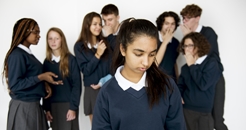 Restorative justice in schools
Restorative justice in schools
Over 24 schools in Oakland, California have implemented restorative justice programmes and these have had a measurable impact on school behaviour and educational outcomes by keeping children in class rather than sending them home as a disciplinary measure. They now plan to expand these to all their schools.
The district said they’ve documented a 60 percent increase in graduation rates and a 128 percent increase in reading levels for students at schools that use restorative justice.
Restorative practices include 'harm circles' which are used to facilitate a group discussion between the offending student and the people affected by his or her actions regarding the personal consequences created for all the parties involved when a conflict arises. This focuses on the harm that was created rather than punishing the behaviour or focusing on the rule that was broken. If someone breaks a rule or harms someone and they are just punished, there’s little or no learning going on compared with allowing students to understand the impact of what they’ve done and then seeking to make it right.
Schools that have implemented restorative justice disciplinary practices report that students now frequently ask for 'harm circles' rather than fighting to settle their differences.
This, along with other programs on positive behaviour, social and emotional learning, achievement, etc., meant that in the 2013-14 school year there were 49,987 fewer suspensions than in the previous year, down 15.2 percent. There were also 1,655 fewer expulsions in the same time frame, down roughly 20 percent. Before these programs were implemented, the single biggest cause of suspension or expulsion by percentage was 'wilful defiance'. In the 2013-14 school year, there was a 47.7 percent drop in the number of students expelled for defiance-related offenses.
Let's now travel to Edmonton, Canada.
Here they use the term 'talking circles' instead of 'harm circles' but their function is just the same. Everyone involved in an incident where a student acted up, will sit in a circle to discuss what happened, and how it affected them. The 'circle keeper' will summarize what happened to prompt the circle. They'll ask people to explain how the incident made them feel, and what effect it had on them. Only the person holding an object — the 'talking piece' — can speak, and no one has to speak if they don't want to. For meetings that involve more than a simple act of resolution, an agreement is devised and signed by all the participants. Staff check in with everyone later to see if they're upholding their end of the agreement.
Talking circles are happening all over Edmonton Public Schools. Each school decides how they'll use them.
Such restorative practices also avoid placing blame, which can help build more trusting relationships between students and school staff. Sending a student away from school further fractures their relationship with the people there, and is ineffective at addressing the problems underlying bad behaviour. Many of the children have stresses in their home life or stresses in their own functioning. Restorative practices give students a chance to repair any harm they've caused, whether it's facing the person they bullied or painting over the wall they graffitied.
Staff now routinely use small, informal circles to resolve minor conflicts. In the event of a more serious problem, like a fight or children bringing drugs to school, administrators organize a larger circle involving the student or students, supportive family members, school staff and any other relevant players.
One head recommended 10 students for expulsion in 2012-13. For the past two years, it's been zero.
What about the UK?
A report published by the Department for Education gave whole-school restorative approaches the highest rating of effectiveness at preventing bullying, with a survey of schools showing 97% rated restorative approaches as effective.
An independent evaluation of restorative justice in Bristol schools found that restorative justice improved school attendance and reduced exclusion rates.
In Barnet, an evaluation by the local authority found a reduction in exclusions of 51% in restorative justice trained schools compared to a 65% increase in exclusions in the thirty two Barnet schools that have received no restorative justice training. They also found increased confidence among school staff to deal with bullying and conflicts in the school.
See details from the Restorative Justice Council.
See Little Book of Restorative Discipline for Schools: Teaching Responsibility, Creating Caring Climates
Interestingly, this approach can also be used in the community to resolve anti-social behaviour and minor disputes. Could the local church take a lead?
Retweet about this article:
Geoff Knott, 19/09/2017